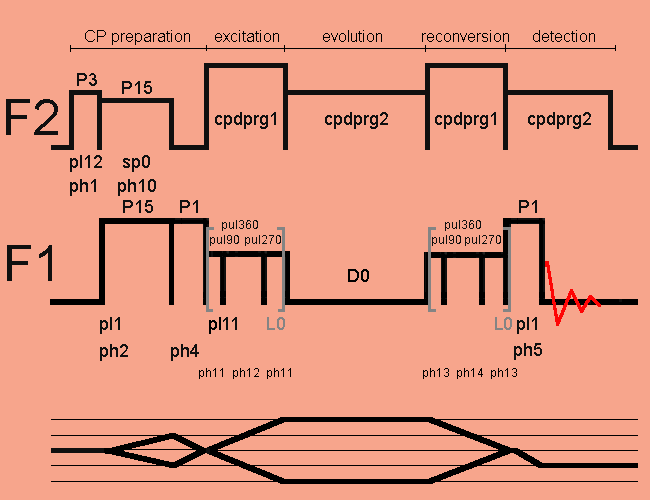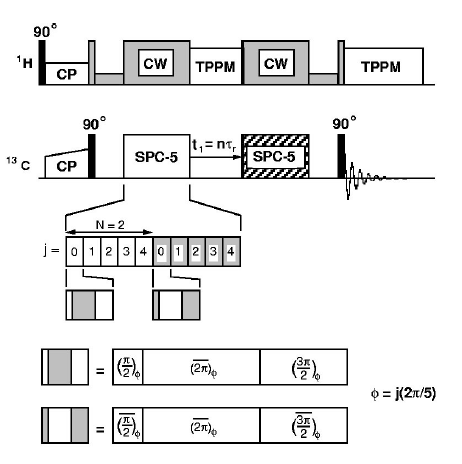
SPC5CP2dbigsw: 2D Big DQ F1 spectral width SPC5 CP pulse program for TopSpin2.1

Since non-phase cycling is applied to the SPC5 excitation pulse, four-phase cycling is applied to the detection pulse P1 for selecting the 0Q -> -1Q coherence order jump, and four-phase cycling is applied to the SPC5 reconversion pulse for filtering DQ coherences.
Avoid cross-polarization during SPC5 excitation and reconversion.
;spc5cp2dbigsw (TopSpin 2.0) ;2D SQ-DQ correlation experiment with SPC5 sequence and cross polarization ;for the original C7 sequence see: Lee et al. Chem Phys Lett 242, 304-309, 1995 ;see Hohwy, Rienstra, Jaroniec and Griffin, JCP 110, 7983, 1999 ;by JOS 03/03/03, modified by HF 14.5.07 ;Avance III version ;parameters: ;d1 : recycle delay ;d0 : incremented delay in t1 evolution [1 µs] ;pl1 : for X contact pulse ;pl2 : =120dB, not used ;pl11 : for SPC5 recoupling sequence B1=5*cnst31 in Hz ;pl12 : for 1H excitation and decoupling ;pl13 : for LG decoupling cpdprg1 = cwlg or cw13 or tppm13 ;sp0 : proton power level during contact ;p1 : excitation pulse f1 at pl1 ;p3 : 1H excitation pulse @ PL12 ;p5 : FSLG 2pi pulse set by lgcalc.incl ;p9 : used as t1 increment for d0 ;p15: HH contact pulse ;pcpd2 : decoupling pulse f2 @ PL12, pcpd = 2*P3-0.2us used by TPPM and SPINAL ;spnam0 : for CP on 1H e.g. ramp.64 ;cpdprg1 : decoupling f2 during SPC5, e.g. cw (or cwlg) or tppm ;cpdprg2 : decoupling f2, e.g. tppm15, SPINAL64 ;cnst20 : LG-RF field as adjusted, in Hz used to calculate cnst22 and cnst23 +and - LG frequency ;cnst21 : =0 frequency reset (set by lgclac.incl) ;cnst22 : +LG frequency offset calc. by lgcalc.incl ;cnst23 : -LG frequency offset calc. by lgcalc.incl ;cnst24 : offset for 1H evol. during FSLG: 0 - -2000 ;cnst31 : spinning speed ;l0 : number of composite SPC5 mq excitation and reconversion cycles multiple of 5 ;ns : 32*n ;nd0 : 1 ;FnMode : undefined because the pulse program contains no mc statement ;mc2 : STATES-TPPI ;WDW : f1 QSINE 3, F2 QSINE 2 or EM ;use "xau xfshear rotate" to shift spectrum suitably along f1 ;$COMMENT=SQ-DQ experiment with SPC5 sequence, optimised for big sweep width, cp for excitation ;$CLASS=Solids ;$DIM=2D ;$TYPE=cross polarisation ;$SUBTYPE=homonuclear correlation ;$OWNER=Bruker define pulse pul360 "pul360=(1s/cnst31)/5" ;360° pulse define pulse pul90 "pul90=(0.25s/cnst31)/5" ; 90° pulse define pulse pul270 "pul270=(0.75s/cnst31)/5" ;270° pulse define loopcounter count ;for STATES-TPPI procedure "count=td1/2" ;and STATES cos/sin procedure "d31=(1s/cnst31)" ;cnst11 : to adjust t=0 for acquisition, if digmod = baseopt "acqt0=1u*cnst11" #include <lgcalc.incl> ;calculates cnst22 from cnst20, RF field at pl13 #include <rot_prot.incl> ;protect for too slow rotation ze ;acquire into a cleared memory "d0=0.1u" ;make sure a short d0 is used initially 1 d31 2 d1 do:f2 ;recycle delay ;F2 decoupler off #include <p15_prot.incl> ;make sure p15 does not exceed 10 msec ;let supervisor change this pulseprogram if ;more is needed #include <aq_prot.incl> ;allows max. 50 msec acquisition time, supervisor ;may change to max. 1s at less than 5 % duty cycle ;and reduced decoupling field "cnst1=180*cnst31*d0" ;phase correction for SPC5 reconversion pulse, ;due to t1 DQ evolution period, ;defined by the phase-time relationships 1m rpp11 ;reset the phase program ph11 pointer to the first element 1m rpp12 ;reset the phase program ph12 pointer to the first element 1m rpp13 ;reset the phase program ph13 pointer to the first element 1m rpp14 ;reset the phase program ph14 pointer to the first element 1u fq=cnst21:f2 (p3 pl12 ph1):f2 ;proton 90° pulse (p15 pl1 ph2):f1 (p15:sp0 ph10):f2 ;contact pulse with square or ;ramp shape ramp.100 on F2 (p1 ph4):f1 ;90° pulse putting magnetization back to z-axis ;for SPC5 double-quantum excitation ;SPC5 DQ excitation: 3 (pul90 pl11 ph11 ipp13 ipp14):f1 (1u cpds1):f2 ;switch to SPC5 RF condition ;increment reconversion pulse phase ph13 and ph14 pointers ;to the next phase in the lists ;F2 decoupling during SPC5: cw (or cwlg) or tppm (pul360 ph12 ipp12):f1 ;increment phase ph12 pointer (pul270 ph11 ipp11):f1 ;increment phase ph11 pointer lo to 3 times l0 ;l0 = multiple of 5 4 d0 ;double-quantum evolution period ;SPC5 DQ reconversion: 5 (pul90 ph13+cnst1):f1 (1u cpds1):f2 ;increase ph13 by cnst1 due to evolution period ;F2 decoupling during SPC5: cw (or cwlg) or tppm (pul360 ph14+cnst1 ipp14):f1 ;increase ph14 by cnst1 due to evolution period, ;increment phase ph14 pointer to the next phase in the list (pul270 ph13+cnst1 ipp13):f1 ;increase ph13 by cnst1 due to evolution period, ;increment phase ph13 pointer to the next phase in the list lo to 5 times l0 ;l0 = multiple of 5 (p1 pl1 ph5):f1 (1u cpds2):f2 ;flip magnetization into the xy plane with the detection pulse ;F2 decoupling with TPPM or SPINAL during acquisition gosc ph31 ;gosc does not loop to 1 ;start ADC with ph31 signal routing 1m do:f2 ;F2 decoupler off ;DQ filtering (four phase cycling): 40u ip13*16384 ;increments all phases of ph13 by 90° 40u ip14*16384 ;increments all phases of ph14 by 90° lo to 1 times ns ;next scan 1m do:f2 ;F2 decoupler off 100m wr #0 if #0 zd ;delay for disk I/O, store signal, ;increase FID number ;delete memory data ;do not perform dummy scans ;with next acquisition 1m ip11*8192 ;increments all phases of ph11 by 45°, ;90° phase for DQ coherence 1m ip12*8192 ;increments all phases of ph12 by 45°, ;90° phase for DQ coherence lo to 1 times 2 ;t1 quadrature detection "d0=d0+p9" ;set p9=inf1=increment for F1 (to make it usec!) ;1m rp11 ;reset all phases of ph11, ph12, ph13, and ph14 ;1m rp12 ;to their original values, i.e. to the values they ;1m rp13 ;had before the first ip11, ip12, ip13, and ip14 ;1m rp14 ;in case of STATES remove semicolon at beginning of the 4 lines lo to 1 times count ;count = td1/2 1m do:f2 ;F2 decoupler off HaltAcqu, 1m exit ph1= 1 1 1 1 3 3 3 3 ph2= 0 ph4= 3 3 3 3 1 1 1 1 ph5= 0 0 0 0 0 0 0 0 2 2 2 2 2 2 2 2 1 1 1 1 1 1 1 1 3 3 3 3 3 3 3 3 ph10=0 ph11= (65536) 0 13107 26214 39322 52429 32768 45875 58982 6554 19661 ph12= (65536) 32768 45875 58982 6554 19661 0 13107 26214 39322 52429 ph13= (65536) 16384 29491 42598 55706 3277 49152 62259 9830 22937 36044 ph14= (65536) 49152 62259 9830 22937 36044 16384 29491 42598 55706 3277 ph31= 0 2 0 2 0 2 0 2 2 0 2 0 2 0 2 0 1 3 1 3 1 3 1 3 3 1 3 1 3 1 3 1

Definition of SPC5 excitation pulse.